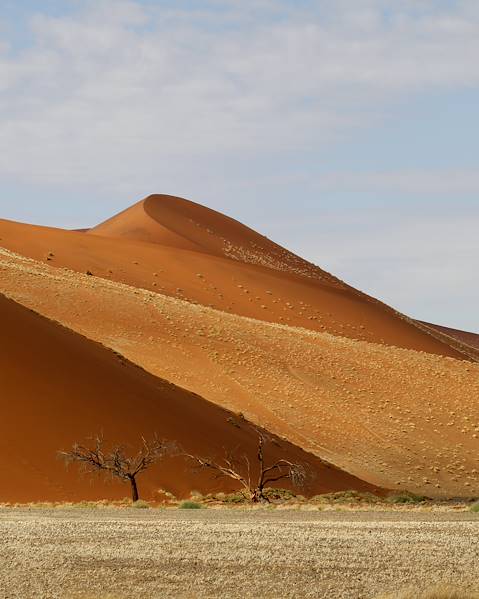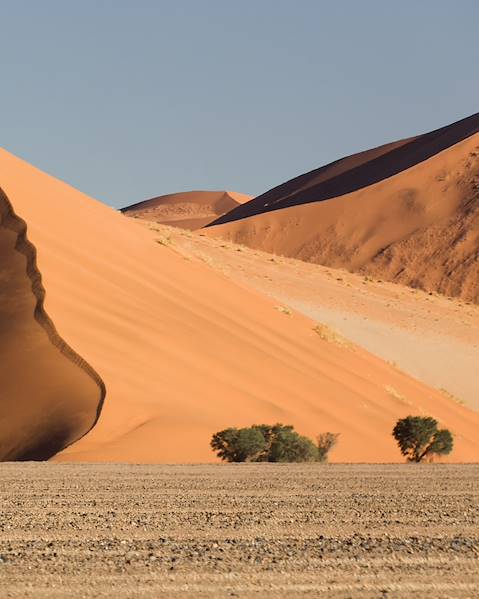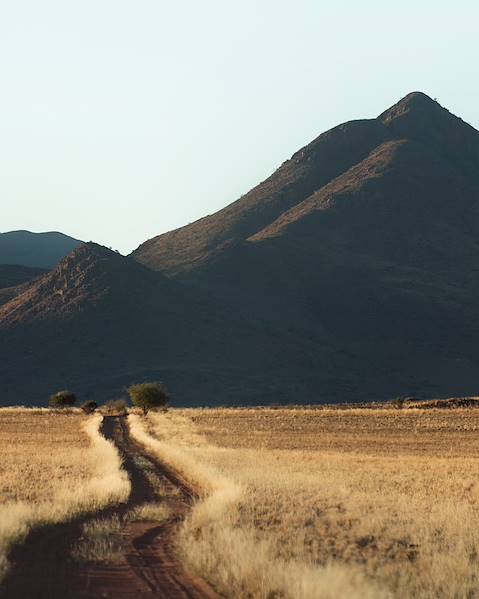Like the country itself, transport in Namibia is geared towards adventure. Fly-in safari goers can savour the country’s spectacular scenery during scheduled flights, or on chartered light aircraft. And although more time consuming, road trips make for great game spotting. The main towns are linked by a bus network, however this is rarely used by tourists, and instead, private transfers and car rental are good ways to take in the country’s countless attractions. Transport in Namibia also includes a limited railway service, as well as tourist trains such as the Namibia Desert Express, combining comfortable accommodation with top-notch dining and sumptuous sightseeing.
By Plane
Given the distances involved, it’s no surprise that internal flights are a popular form of transport in Namibia. Hosea Kutako International Airport, just outside the capital Windhoek, is the main international gateway. It serves as a hub for various airlines, connecting Namibia to major cities in Africa, Europe and beyond. In addition to a second international airport at Walvis Bay, smaller airports are scattered across the country at Katima Mulilo, Lüderitz, Ondangwa, Oranjemund and Rundu.
Domestic Flights
Namibia has a well-developed domestic flight network, with a handful of airlines offering flights to various destinations within the country. Air Namibia operates several flights a week on domestic routes from Hosea Kutako International Airport or from Eros Airport – Windhoek’s domestic airport, a few miles south of the capital. Destinations include major towns and tourist hubs, such as Swakopmund, Walvis Bay and Etosha National Park.
Charter Flights
As well as providing stunning aerial views of Namibia’s contrasting landscapes, charter flights allow visitors to reach areas where road access is limited. Airstrips are dotted around the country and many of the more isolated luxury lodges even have their own landing strip. If you want to see multiple regions in Namibia (and who wouldn’t?), our experts can book the best charter operators, who specialise in flying between accommodations. For example, our flying safari along the Skeleton Coast takes you to some of the country’s most remote areas. Hop in and out of light aircraft along this hauntingly beautiful stretch of coastline, spotting seal colonies, diverse geological formations and – if you're lucky – the endangered black rhino, en route.
By Road
Road travel is the most common mode of transport in Namibia, offering both flexibility and convenience. The country has a well-maintained road network, with tarred routes connecting major cities and towns. The B1 highway, for example, runs from Windhoek to the northern town of Ondangwa, passing through several towns and attractions along the way.
Car Rental
By far the most convenient way to see Namibia is having your own set of wheels. Car rental provides the freedom to explore at your own pace and access remote areas. For the ultimate adventure, take a road trip from Windhoek to the awe-inspiring Fish River Canyon. Drive along the base of the Naukluft Mountains, staying in bucolic villages and luxury lodges en route. Several international car rental companies operate in Namibia, offering a wide range of vehicles suitable for different terrains. However, it’s important to note that some roads, especially in rural areas, may be gravel or sand and will require a 4x4 for safe travel. If you’re unsure what type of vehicle you’ll need, our experts can arrange transport that’s tailored to your trip.
By Organised Tour
If you don’t have your own vehicle, or don’t want to spend hours driving, the easiest way to visit places is to go on an organised tour or safari. These range from three-day camping trips to Sossusvlei, to bespoke tours for as long and as far as you’d like.
By Bus
Buses are another means of transport in Namibia, although they are less commonly taken by visitors. They operate on fixed routes, connecting major towns and cities, while minibuses – known as ‘combis’ – are more flexible, stopping to pick passengers up along the way. Private operators, such as Intercape Mainliner, run daily services from Windhoek to hubs across the country, as well as to South Africa and Zambia. Other operators run air-conditioned shuttle services to specific destinations.
By Rail
Rail travel is not as popular as road or air transport in Namibia, mainly due to the limited routes and longer travel times. However, for those seeking a leisurely journey and a chance to admire the country’s landscapes, trains can be an appealing option.
Public Trains
Generally, Namibia's trains cater better for freight than visitors. That said, the TransNamib Railway operates passenger trains connecting major towns, including Windhoek, Swakopmund and Walvis Bay. If you do choose to travel this way, remember to take food and a blanket to ward off the desert chill and make the journey more comfortable.
Tourist Trains
At the other end of the scale, there are romantic and nostalgic train journeys to be had, such as the luxurious Desert Express. Despite having the word ‘express’ in its name, the Namibia Desert Express actually takes 22 hours to travel from Windhoek to Swakopmund; however, this allows plenty of time to appreciate the train’s opulence and gaze at the desert landscape, while reclining in the soft leather seats.
By Bike and On Foot
Namibia’s vast and diverse landscapes lend themselves to outdoor exploration and make it an ideal destination for cycling and walking enthusiasts. Cycling tours allow travellers to explore the country’s natural wonders at a slower pace. From cycling through the Namib Desert to pedalling along the scenic coastal roads, tours offer an alternative perspective on Namibia’s beauty. Walking safaris are also popular and provide an intimate way of connecting with nature. Guided hikes through national parks, such as Fish River Canyon or the Waterberg Plateau, invite visitors to immerse themselves in the stunning scenery and encounter wildlife up close.
















